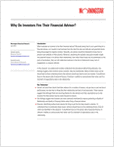About a year after he became CEO of clearing and custodial firm BNY Mellon | Pershing, Jim Crowley paused his busy schedule to reflect on the whirlwind of change he’s seen at the firm due to the coronavirus and remote work.
Pershing — which serves about 725 RIA firms with over $850 billion in advisory assets — lowered its minimum asset level to $100 million (from $250 million) earlier this year ahead of Charles Schwab’s acquisition of TD Ameritrade, and gave its RIA clients two more pay options for custodial services — subscriptions and zero-transaction-fee pricing.
Since the start of 2020, it’s also tapped Ben Harrison to take the reins from Mark Tibergien as head of Advisor Solutions and Emily Schlosser to become its chief operating officer — a role previously held by Crowley.
Here are highlights of the CEO’s interview with ThinkAdvisor:
THINKADVISOR: How has the clearing and custody business changed since the COVID-19 pandemic?
JIM CROWLEY: The pandemic proved to be one of the greatest tests for our industry. Stability, resiliency and business continuity — always critical, yet not always the most exciting, topics — became hot-button issues overnight.
Historic volatility in the markets led to unprecedented levels of activity, where trading volumes on our platform at times reached three times the normal levels. This, paired with a completely remote environment, resulted in a situation no one could have planned for.
The biggest lesson we learned as an industry since the pandemic is that there is no substitute for business continuity planning and testing systems on a frequent basis.
Further, the new virtual world that’s emerged since the pandemic has made it a business imperative to shift to a digital environment and become paper-free.
Moving forward, we will all need to put more effort behind helping our clients adapt to this digital environment and become comfortable using tools such as e-signature, e-delivery and electronic processing of checks and disbursements.
For us that means now more than ever, business is about making it simpler and easier to use digital tools and tap into expertise so our clients can continue to serve their clients and drive growth.
How has the pandemic changed your and your clients’ priorities?
The pandemic forced us to rethink everything from how we conduct business to how we manage our teams and employees and how we interact with clients.
Communication has become a central pillar of our client and employee management strategy. Over the past six months, we have significantly increased the frequency of our employee communications to try to ensure we are addressing employee concerns in a highly fluid environment.
While we have always been a people-first company, the well-being of our employees has taken on a new importance. We are making every effort to provide our employees with added flexibility to help them juggle multiple priorities and challenges, as well as bringing them new resources to help them manage stress and build resiliency.
The rapid and unexpected transition to a virtual world has essentially forced everyone to rethink and redefine their technology strategy. Adoption of new technology went from being optional to being essential.
In light of this profound shift, we have significantly increased our touch points with clients to support them in their transition to the new normal.
What are you doing differently to address the changes in the business environment? What are your focus areas?
Our focus has been — and continues to be — on helping clients run their business more efficiently so they can serve their clients more effectively.
In many ways, the pandemic validated our long-held strategies and ongoing investments in modernizing and strengthening our platform, simplifying and streamlining the user experience and helping our clients drive profitable growth.
We are adding new features to make it easier and more secure for clients to access our platform. We recently introduced fingerprint and facial-recognition capabilities for advisors using the NetX360 desktop.
We are also delivering better operational efficiencies and making our processes even more user friendly. For example, to accelerate adoption of e-delivery, we implemented an easy button so clients can enroll all documents in e-delivery via the NetXInvestor client portal.
We are digitizing the asset movement experience to help advisors speed up the time it takes to obtain client signatures. We are working on digital authorizations for asset movements like fed funds, journals and ACH, replacing the need to wait for the client letter of authorization.
We are also deepening integrations with best-of-breed providers in high demand by our clients to make it easier to access different technology solutions.
And we hired a new chief operating officer, Emily Schlosser. Virtually onboarding a C-Suite executive was a first for us. Emily’s background at industry leaders and startups, leading operations and change management will bring a new perspective to our operations.
What are the specific initiatives you have in place to help clients drive growth?









 October 06, 2020 at 11:30 AM
October 06, 2020 at 11:30 AM










